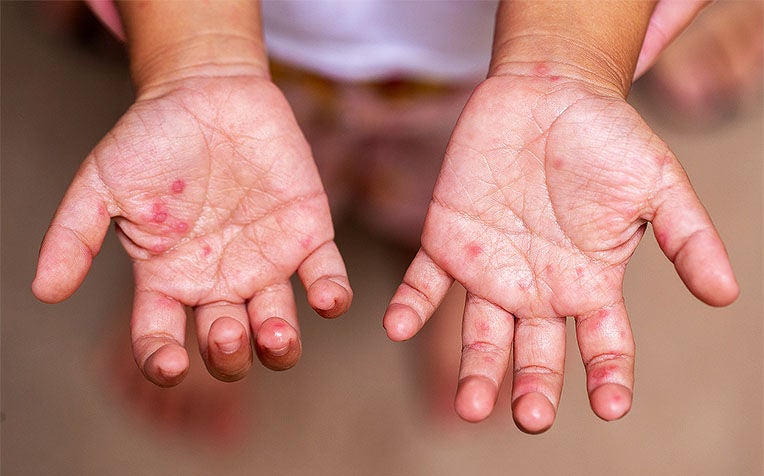
Hand foot mouth disease (HFMD) tends to infect young children below the age of five, but adults can get it too!
A blister-like rash on the hands and feet as well as ulcers in the mouth are the main symptoms of HFMD (hand foot mouth disease), and give this infectious disease its name.
HFMD is a viral disease that is endemic in Singapore, which means it occurs regularly.
See below for when to visit the emergency for HFMD (rare cases).
While both children and adults can get HFMD, young children below the age of 5 are most susceptible to it. There are active HFMD clusters across the country, and the Ministry of Health provides regular updates on the affected kindergartens and childcare centres so parents can protect their children.
“HFMD is usually a mild disease and children rarely suffer serious complications from it,” says Associate Professor Chong Chia Yin, Senior Consultant from the Infectious Disease Service at KK Women’s and Children’s Hospital (KKH), a member of the SingHealth group.
She shares tips on how to prevent HFMD and what to do if your child contracts the disease.
Watch the video!
How to prevent Hand Foot Mouth Disease (HFMD)
Good personal hygiene is the best way to protect yourself and your child from getting HFMD. You can teach your child the following hygiene practices:
Wash hands with soap and water before and after eating and after going to the toilet.
Do not share your food, drinks, plate, bowl, glass or cutlery while eating.
Do not share towels, toothbrushes or other personal items.
Cover your mouth and nose with a tissue when coughing or sneezing.
Throw used tissues into the rubbish bin and immediately wash your hands with soap and water.
What to do if there is an HFMD outbreak in your child’s kindergarten or childcare centre
You can take the following precautionary steps if there is an outbreak of HFMD in your child’s kindergarten or childcare centre:
Monitor your child’s temperature daily.
Wash your child’s hands before leaving the childcare centre.
Your child should shower, shampoo the hair and change into a clean set of clothes when reaching home.
Check daily for mouth ulcers and blisters on the hands and feet of your child.
Consult your family doctor if you notice any symptoms of HFMD.
What to do if you child gets Hand Foot Mouth Disease (HFMD)
“An infected child should avoid school and crowded places for at least 10 days after the symptoms of HFMD have appeared,” advises Assoc Prof Chong.
1. HFMD: How to treat
There is no specific treatment for HFMD and children usually recover on their own in about a week, as their immune system fights the virus. Antibiotics are not effective for the treatment of HFMD since it is a viral infection.
However, the following measures can be taken to relieve symptoms:
Give fever medication to relieve fever or pain.
If the child has difficulty swallowing or eating due to the mouth sores, try an over-the-counter mouth gel or lozenges (for older children able to suck on sweets) to numb the mouth pain.
Give frequent small amount of liquids at room temperature such as milk, diluted juice, rice water or barley water as tolerated to prevent dehydration. You may try soft foods including ice cream, pureed fruit or porridge.
Ensure adequate rest.
A child who gets HFMD infection is not protected from getting the disease again so parents need to remain vigilant.
2. HFMD: Tips to prevent spreading to others
If your child gets HFMD, you can take the following steps to prevent the spread to others.
![]() Keep the infected child home and away from school, kindergarten, childcare centre and public places until the rash has dried up and the child has fully recovered.
Keep the infected child home and away from school, kindergarten, childcare centre and public places until the rash has dried up and the child has fully recovered.
![]() As much as possible, separate the infected child from other children and adults at home.
As much as possible, separate the infected child from other children and adults at home.
![]() Inform the school, kindergarten or childcare centre immediately so they can monitor other children and take precautions.
Inform the school, kindergarten or childcare centre immediately so they can monitor other children and take precautions.
![]() Avoid kissing or hugging the infected child.
Avoid kissing or hugging the infected child.
![]() Look out for symptoms in other family members, both children and adults.
Look out for symptoms in other family members, both children and adults.
![]() Keep the infected child’s toys, books, eating utensils, towels, toothbrush and clothes separate and disinfect the items after the child recovers.
Keep the infected child’s toys, books, eating utensils, towels, toothbrush and clothes separate and disinfect the items after the child recovers.
![]() Wash your hands with soap and water immediately when you change a diaper, touch or have contact with the infected child’s body fluids or secretions such as saliva, nasal mucus, vomit, urine or stool.
Wash your hands with soap and water immediately when you change a diaper, touch or have contact with the infected child’s body fluids or secretions such as saliva, nasal mucus, vomit, urine or stool.
![]() If the infected child needs to see a doctor, call before visiting your general practitioner (GP). This will help the GP take steps to keep other people from being infected.
If the infected child needs to see a doctor, call before visiting your general practitioner (GP). This will help the GP take steps to keep other people from being infected.
![]() Clean all frequently-touched surfaces, e.g. toilet, bathroom fixtures, doorknobs and soiled items including toys. Also, clean any surfaces that may have body fluids and/or secretions on them. Use a diluted bleach solution or a household disinfectant. To make a bleach solution at home, add one tablespoon of bleach to about one litre of water. If possible, wear disposable gloves when cleaning. After cleaning, wash your hands thoroughly with soap and water.
Clean all frequently-touched surfaces, e.g. toilet, bathroom fixtures, doorknobs and soiled items including toys. Also, clean any surfaces that may have body fluids and/or secretions on them. Use a diluted bleach solution or a household disinfectant. To make a bleach solution at home, add one tablespoon of bleach to about one litre of water. If possible, wear disposable gloves when cleaning. After cleaning, wash your hands thoroughly with soap and water.
![]() Wash the laundry thoroughly. Immediately remove and wash clothes or bedding that have body fluids or secretions on them. Wash these items with detergent and warm water, using the longest cycle available, then dry them.
Wash the laundry thoroughly. Immediately remove and wash clothes or bedding that have body fluids or secretions on them. Wash these items with detergent and warm water, using the longest cycle available, then dry them.
“If a child in the family has HFMD, the key to prevent the infection from spreading to other children or adults is good hygiene,” says Associate Professor Chong. Even adults can get HFMD, so steps must be taken to prevent one from catching the infection.
3. When to visit the emergency for HFMD (rare cases)
HFMD usually presents with mild symptoms in children. However, complications affecting the brain, lung or heart may occur in rare cases where the infection is caused by a more severe virus strain.
Take your child to the nearest doctor or emergency unit
immediately if the following symptoms occur:
Difficulty in breathing
Face turning blue or ashen and pale
Drowsiness and disorientation
Severe headache or irritable
Stiff neck
Dizziness
Fits
Vomiting or poor oral intake
Decreased urination or dry tongue
About Hand Foot Mouth Disease (HFMD)
HFMD is caused by the enterovirus family of viruses, most commonly the coxsackie virus. It spreads through direct contact with an infected person’s fluids such as saliva, nasal discharge, faeces or fluid from rash.
Symptoms of HFMD take 3-7 days to show up after infection. The illness usually last for 7 days but the virus can be present in the stools of an infected child for as long as 12 weeks and in the saliva up to 4 weeks. Fever generally lasts up to 5 days.
Symptoms of Hand Foot Mouth Disease (HFMD)
Symptoms of HFMD include the following:
Rash on hands, feet and buttocks (can look like pimples, flat red spots or blisters)
Ulcers in the throat or mouth or on the tongue
Fever
Headache
Sore throat
Runny nose
Vomiting
Diarrhoea
Fatigue
Loss of appetite
Ref: I23
Check out related articles:


















 Get it on Google Play
Get it on Google Play